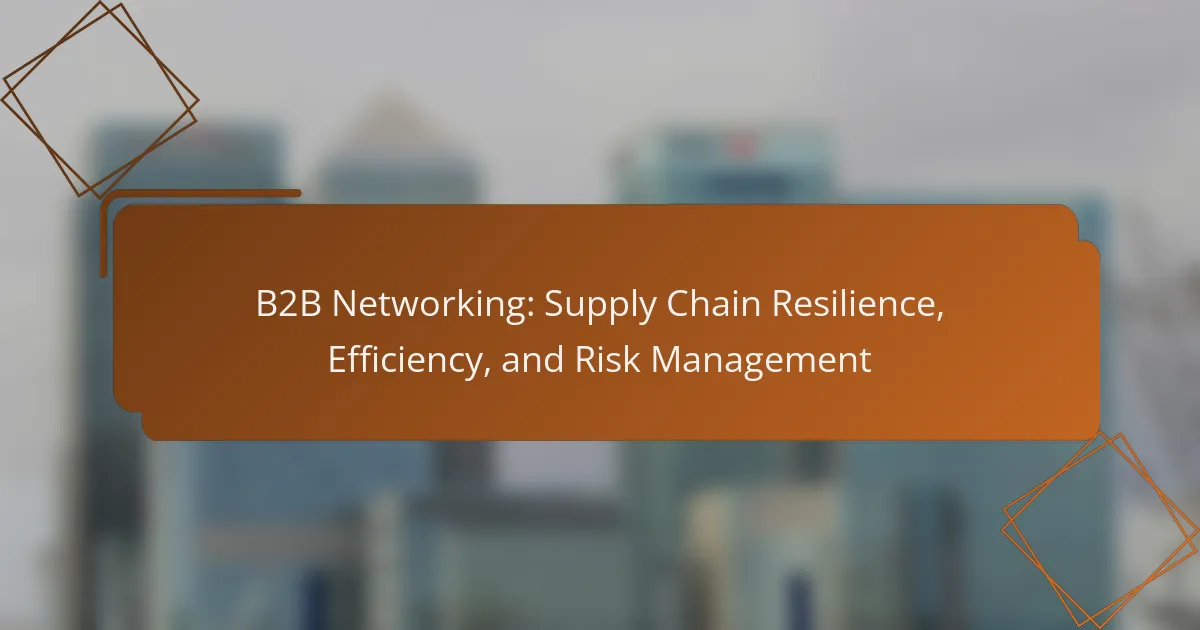B2B networking plays a crucial role in enhancing supply chain resilience by building stronger partnerships that facilitate rapid responses to disruptions and boost overall efficiency. By focusing on collaboration, businesses can better adapt to challenges, streamline communication, and leverage technology to optimize processes. Additionally, effective risk management strategies, such as supplier diversification and contingency planning, are essential for mitigating potential disruptions and ensuring continuity in operations.

How Can B2B Networking Enhance Supply Chain Resilience?
B2B networking can significantly enhance supply chain resilience by fostering stronger relationships among partners, enabling quicker responses to disruptions, and improving overall efficiency. By leveraging collaborative efforts, businesses can adapt more readily to challenges and maintain continuity in operations.
Increased collaboration
Increased collaboration among businesses allows for shared knowledge and resources, which can lead to more innovative solutions during supply chain disruptions. Collaborative networks can facilitate joint problem-solving and resource pooling, helping companies to navigate challenges more effectively.
For example, companies within a network can work together to develop contingency plans or share logistics capabilities, reducing individual risk and enhancing collective resilience.
Access to diverse resources
B2B networking provides access to a wider range of resources, including suppliers, technologies, and expertise. This diversity can be crucial in times of crisis, as businesses can quickly pivot to alternative suppliers or solutions when their primary sources are compromised.
Utilizing a diverse supplier base can also help mitigate risks associated with over-reliance on a single source, ensuring that companies can maintain operations even when faced with unexpected challenges.
Real-time information sharing
Real-time information sharing is vital for enhancing supply chain resilience. By exchanging data on inventory levels, demand fluctuations, and potential disruptions, businesses can make informed decisions quickly.
Implementing digital platforms that facilitate real-time communication can streamline operations and improve responsiveness, allowing companies to adjust their strategies based on the latest information.
Risk mitigation strategies
Effective risk mitigation strategies are essential for maintaining supply chain resilience. B2B networks can help identify potential risks and develop strategies to address them, such as diversifying suppliers or investing in technology for better forecasting.
Regular risk assessments and scenario planning within the network can prepare businesses for various disruptions, ensuring they are better equipped to handle unforeseen events.
Case studies of successful networks
Examining case studies of successful B2B networks can provide valuable insights into best practices for enhancing supply chain resilience. For instance, a network of automotive suppliers may collaborate to streamline logistics and share best practices, resulting in reduced costs and improved delivery times.
These case studies often highlight the importance of trust and communication among partners, demonstrating how strong relationships can lead to more resilient supply chains capable of weathering disruptions effectively.

What Strategies Improve Supply Chain Efficiency?
Improving supply chain efficiency involves implementing strategies that enhance communication, leverage technology, and optimize processes. Key approaches include streamlining communication channels, utilizing automation tools, applying data analytics, and adopting lean management principles.
Streamlined communication channels
Effective communication is crucial for supply chain efficiency. Establishing streamlined channels ensures that all stakeholders, from suppliers to logistics providers, are on the same page. Tools like instant messaging and collaborative platforms can reduce response times and improve coordination.
Consider implementing regular check-ins and updates to keep everyone informed. This can help identify potential issues early, allowing for quicker resolutions and minimizing disruptions.
Automation tools like SAP Ariba
Automation tools such as SAP Ariba can significantly enhance supply chain efficiency by automating procurement processes and managing supplier relationships. These tools reduce manual tasks, allowing teams to focus on strategic initiatives rather than administrative work.
When selecting an automation tool, evaluate its integration capabilities with existing systems and its ability to provide real-time data. This can lead to better decision-making and improved supplier performance.
Data analytics for decision-making
Data analytics plays a vital role in enhancing supply chain efficiency by providing insights into performance metrics and trends. By analyzing data, companies can identify bottlenecks, forecast demand, and optimize inventory levels.
Utilize analytics tools to track key performance indicators (KPIs) such as order fulfillment rates and lead times. This information can guide strategic decisions and help in adjusting operations proactively to meet market demands.
Lean management principles
Adopting lean management principles can streamline operations and eliminate waste in the supply chain. This approach focuses on maximizing value while minimizing resources, leading to increased efficiency and reduced costs.
Implement practices such as just-in-time inventory and continuous improvement initiatives. Regularly review processes to identify areas for enhancement, ensuring that your supply chain remains agile and responsive to changes in demand.

How to Manage Risks in B2B Supply Chains?
Managing risks in B2B supply chains involves identifying potential disruptions and implementing strategies to mitigate their impact. Key approaches include risk assessment frameworks, supplier diversification, contingency planning, and insurance options tailored for supply chain disruptions.
Risk assessment frameworks
Risk assessment frameworks provide structured methods for identifying, analyzing, and prioritizing risks within supply chains. Common frameworks include the ISO 31000 standard, which emphasizes a systematic approach to risk management, and the COSO framework, which focuses on internal controls and governance.
To effectively utilize these frameworks, businesses should regularly evaluate their supply chain processes and identify vulnerabilities. This can involve conducting SWOT analyses (Strengths, Weaknesses, Opportunities, Threats) to pinpoint areas of concern and develop targeted strategies for improvement.
Supplier diversification
Supplier diversification reduces dependency on a single source, thereby enhancing supply chain resilience. By engaging multiple suppliers across different regions or sectors, businesses can mitigate risks associated with disruptions, such as natural disasters or geopolitical tensions.
A practical approach is to maintain a balanced portfolio of suppliers, ensuring that no single supplier accounts for more than a certain percentage of total procurement. This could be around 20-30% for critical components, allowing for flexibility and continuity in operations.
Contingency planning
Contingency planning involves developing proactive strategies to address potential supply chain disruptions. This includes creating response plans that outline specific actions to take during various scenarios, such as supplier failure or transportation delays.
Effective contingency plans should include clear communication protocols, designated response teams, and predefined alternative suppliers. Regular drills and updates to these plans ensure that all stakeholders are prepared to act swiftly when issues arise.
Insurance options for supply chain disruptions
Insurance can serve as a financial safety net against supply chain disruptions. Various policies, such as business interruption insurance and cargo insurance, can help cover losses incurred from delays or damages during transit.
When selecting insurance options, businesses should assess their specific risks and choose policies that align with their supply chain structure. It’s advisable to consult with insurance experts to tailor coverage that adequately protects against the most likely disruptions faced in their industry.

What Are the Key Metrics for Assessing Supply Chain Performance?
Key metrics for assessing supply chain performance include on-time delivery rates, inventory turnover ratios, and cost per order. These indicators help businesses evaluate efficiency, identify areas for improvement, and manage risks effectively.
On-time delivery rates
On-time delivery rates measure the percentage of orders delivered by the promised date. A high rate indicates reliability and efficiency, which are crucial for maintaining customer satisfaction and trust.
To improve on-time delivery, companies should streamline logistics processes and enhance communication with suppliers. Regularly reviewing delivery performance can help identify bottlenecks and areas needing attention.
Inventory turnover ratios
Inventory turnover ratios indicate how often inventory is sold and replaced over a specific period. A higher ratio suggests efficient inventory management, while a lower ratio may signal overstocking or slow sales.
To optimize inventory turnover, businesses should analyze sales trends and adjust purchasing strategies accordingly. Aim for a turnover ratio that aligns with industry standards, typically ranging from 5 to 10 times per year, depending on the sector.
Cost per order
Cost per order refers to the total expenses incurred to process a single order, including shipping, handling, and administrative costs. Keeping this cost low is essential for maintaining profitability.
To reduce cost per order, companies can leverage technology for automation, negotiate better rates with suppliers, and optimize packaging. Regularly tracking this metric helps identify cost-saving opportunities and improve overall supply chain efficiency.

What Role Does Technology Play in Supply Chain Resilience?
Technology is crucial for enhancing supply chain resilience by enabling real-time data sharing, improving visibility, and facilitating quick decision-making. It helps businesses adapt to disruptions, streamline operations, and manage risks effectively.
Blockchain for transparency
Blockchain technology enhances supply chain transparency by providing a secure, immutable ledger of transactions. Each participant in the supply chain can access the same information, reducing discrepancies and fostering trust among stakeholders.
Implementing blockchain can streamline processes such as tracking goods, verifying authenticity, and ensuring compliance with regulations. For example, companies can trace the origin of products, which is vital in industries like food and pharmaceuticals where safety is paramount.
To effectively leverage blockchain, businesses should consider the costs of implementation and the need for collaboration among supply chain partners. Establishing clear governance and standards is essential to maximize the benefits while minimizing potential pitfalls.
